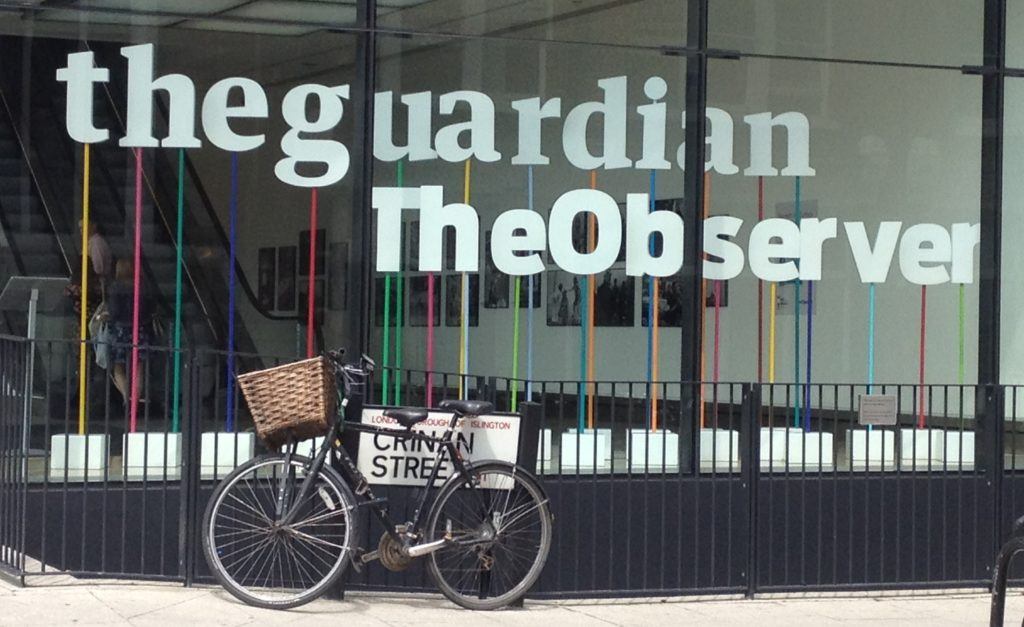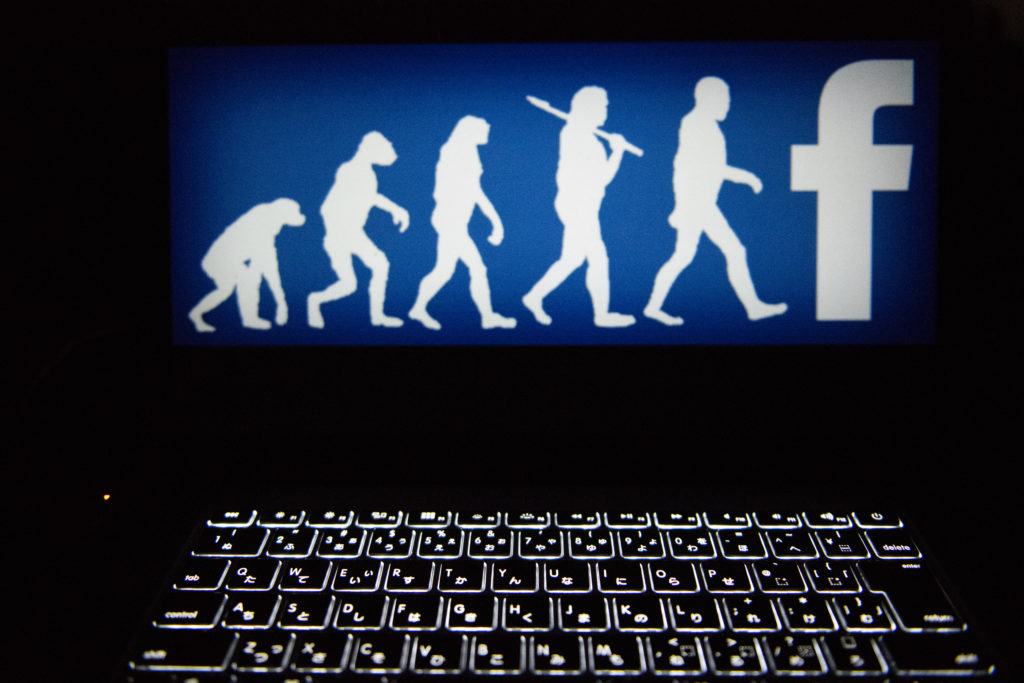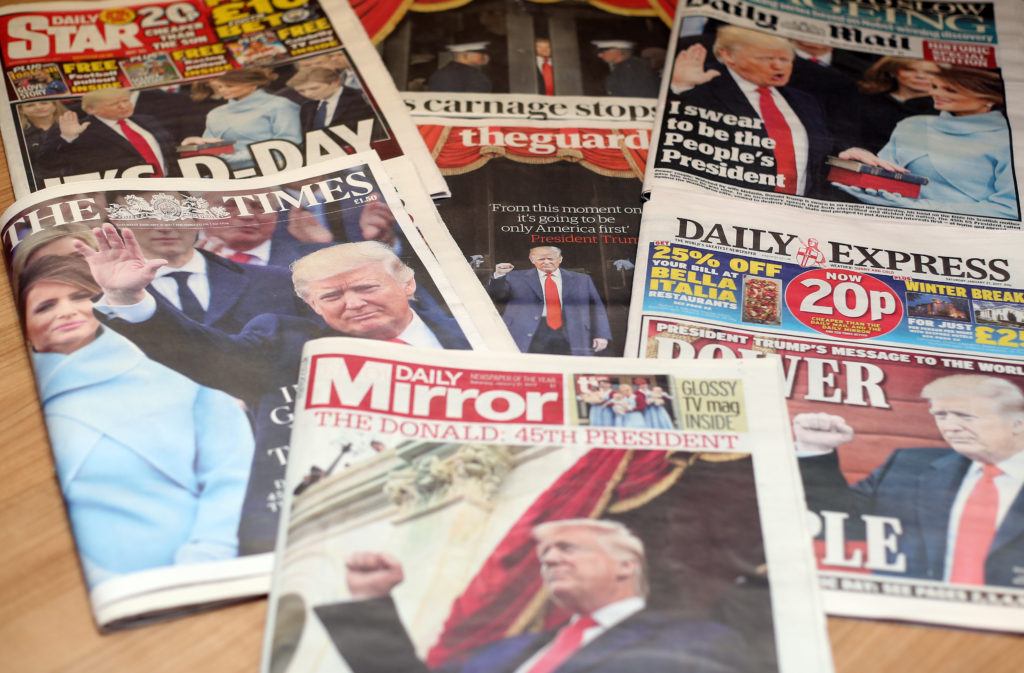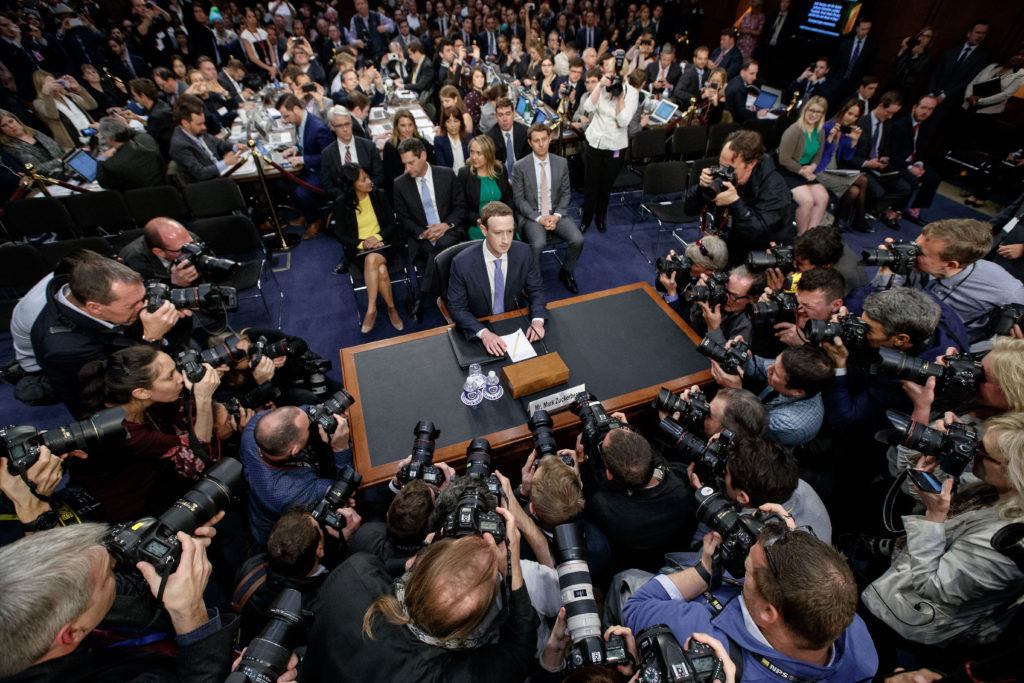Sony press conference (Photo by David McNew/Getty Images)

The internet’s impact on journalism has been traumatic. What initially appeared to be a terrific opportunity for established media to extend their reach to a global community soon transformed into a succession of crises.
There has been no more engaged observer of these developments than Emily Bell. First digital editor of the UK’s ‘Guardian’ newspaper, she was wooed by New York’s Columbia University to head its Tow Center for Digital Journalism. She retains her association with The Guardian as a member of the Scott Trust (which owns The Guardian and The Observer). So she spans both the Atlantic and the worlds of old and new media.
When UnHerd was looking to focus on the future of journalism and the impact on it of social media, we were anxious to hear from her. These are lightly-edited excerpts from her interview with Nigel Cameron, our tech editor.
Those pre-Facebook days
The dawn of the commercial internet was around 1995 – internet 1.0. Most publishers began to be aware that there was this thing called the internet that would affect their businesses and that they needed to do something about it. In the very early days for journalism it meant that we saw things through a pretty narrow lens. Publisher after publisher imagined a world in which they could just publish more – in other words they thought it would be an expansion of the existing pipes. A way of just pushing more text and still pictures onto the public, because of course that was what we were talking about back then.
There was a period of around five years between 1995 and 2000 when publishers thought this would just be a big opportunity to basically put newspapers online, almost literally. I remember that the Daily Telegraph was the first – I recall going to the launch at the Science Museum. We watched a video of a newspaper on the internet, complete with the ads placed where they were in the print edition.
Then we all started to work on what this would really mean. In 1999 my boss, Alan Rusbridger, wrote a piece in The Guardian about how he thought by 2020 we wouldn’t have print any more. A bit of an over-estimate, but the broad direction of travel he got right.

When readers began to post…
So in the pre-Facebook period that stretches from 1995 to 2005 you had a lot of what now looks like pretty crude experimentation. Some of the more experimental – and I think The Guardian was the most experimental in the world – did begin to add talk threads, for instance, where readers would post things themselves.
That may seem like very small fry these days, but it was a big philosophical step for a company that had spent over 100 years editing everything that it put under its masthead to allow not merely journalists, but anyone, to post things. It was a really significant change in how we thought about connecting to our readers, and also about taking risks.
But then in 2002-04 web 2.0 technologies started to emerge, and peer-to-peer networks, commenting systems, the ability of anybody to post multi-media from anywhere at any point… That was when the publishing industry started to realise that it wasn’t just going to be a disruption to the form or frequency with which they published, but a complete inversion of the way that people consumed, made, participated in, media.
Some of us had already realised that this was going to be a really significant change. But we still saw the real-time social web as something that journalists could participate in as long as their news organisations were digitally literate enough – providing new kinds of services and voices to a much broader, often global, public. It was an exciting time, and don’t forget that up until 2005 we might not have been making huge amounts of money but we were certainly breaking even and seeing very good returns on advertising revenue. So when people say why on earth didn’t you all put up paywalls in 2000 or 1996, the answer was that there was a very healthy initial advertising environment.
Facebook and Google: the advertising revolution
But that was where the real change occurred. The disruption from Facebook and Google wasn’t so much in the creation or distribution of content, but in the advertising model. It was totally re-created through targeting technologies based on people’s behavioural information.
For broadsheets, broadly speaking, the split of revenue in high-quality news organisations was 70% advertising, and 30% reader or subscription revenue. You could invert that in the tabloid press. But advertising completely underwrote the press, and had done for 150 years.
We could see that it was going to migrate. First, Craigslist came along with chronically low overheads and a free classified offer. In places like The Guardian that were heavily dependent on classifieds, we realised we had to re-think our own classified businesses. With the passage of time, we came to see a coming exit from classified – which was pretty terrifying for local papers and for big publishers. But we still felt that Google was really bad at delivering what we call display advertising, which would still be a pretty healthy business online if we could connect audiences to products in a slightly more creative way. But then that opportunity disappeared as phones became smartphones and Facebook went public.
Today, in the real-time social web, nearly all social consumption takes place through mobile. Social and mobile are basically the same thing. We might have 30-40 apps loaded on our phones, but on average we only use five or six every day, and the percentage of overall usage is about 30-40%; news and weather apps are about 3%. So if you’re trying to get people to come to your owned and operated property, particularly in the mobile environment which is increasingly where your readership is located, well, you’re playing a losing game.
In any case, digital for many in news organisations both on the commercial and editorial side always felt like a forced march. Print is a very specific set of skills, and some of them are transferable to digital but some are quite different. The journalists, the reporters, had the easiest time, because really in a way they were the ones least affected by how the format was being changed; and they really liked the idea that you could get stories out to people in different ways, and report them as they happen. But for everybody else, there was a lot of foot-dragging. People were pretty scared. They could see that disruption was not necessarily going to be a good thing for them.
Facebook’s arrival was not just a challenge to traditional journalism and publishing, but also to a lot of other social networks set up between 2000 and 2010 – they were all swept away by Twitter and Facebook. And back in 2013-14 everyone thought Twitter was going to be bigger than Facebook. But then, through superior strategy, Facebook began to swallow up journalism and swallow up the rest of the world.
Instagram and IPO: Facebook’s brilliant strategy
The two things it did that were absolutely genius moves in the market, which people underestimated at the time, were purchasing Instagram in 2012 for $1 billion, which seemed an absurd amount of money, and pivoting into mobile; Instagram gave them a hinge. So pre- the Instagram purchase, and pre- the Public Offering, people thought that Facebook didn’t really get mobile, didn’t feel like a mobile site, and they were pretty stuck in their tech. Post- the IPO and re-investment in mobile with the purchase of Instagram, things started to look really different.

And that’s when journalists began to really think, hang on a second, if this platform grows at the rate it’s growing at the moment… The thing about Twitter is it’s a broadcast platform – composed of links back to our world. Facebook has become much more of a walled garden. They have your identity, they publish long posts and pictures, and it’s very clear that they are encouraging you to do that regularly. I think 2013-14 was when people in the publishing industry really started to see Facebook as a revenue generator – that they might be able to reach a different audience on, or that could very easily take their business away overnight.
In 2014, I gave the annual lecture at the Reuters Institute, which was entitled prophetically “Silicon Valley and Journalism: Make-up or Break-up?” – in which I described the fraught nature of this relationship. Silicon Valley companies, especially Facebook and Google, and to some extent Twitter, were taking on some aspects of being publishers without picking up on the responsibility or the real cost of creation. And, therefore, it was beholden to the news industry and the Valley to work out what that relationship really meant, particularly since these platforms are not very clear about their intent. They don’t see themselves as publishers, or certainly didn’t in 2013 or 2014, even though those of us who study publishing do see that that is very clearly the direction of travel.
The feeling that they could sidestep their responsibility by just insisting that this was a mutual technology was so patently not going to hold.
Facebook goes after the old publishers . . .
From 2015 we saw this rapid roll-out of new products aimed specifically at publishers. These were from Facebook, from Google, from Apple, from Twitter, all designed to capture more of your content and more of your audience’s attention and time and keep them within whichever app it was they were on. The idea was that it would be good for publishers, because there would be a beneficial financial relationship that would formalise the somewhat scrappy and somewhat adversarial relationships of the past.
But the money just didn’t move quickly enough to the publishers, and in some sectors – particularly local journalism – the devastating effects of having two players (Facebook and Google) in the market mop up 90% of the growth, particularly in mobile, meant that local newspapers started to close.
. . . and sees off the new?
And in the last year we’ve seen the digitally native companies that everybody thought would be the new institutions – the Buzzfeeds, the Voxes, and so on – beginning to fail. And they’ve begun to fail because they don’t have a model that can survive outside the patronage of something like Facebook, and Facebook is not going to pay Jonah Peretti (Buzzfeed CEO) enough to maintain a 2,000-person creative workforce around the country when Facebook can actually be doing that and making bigger margins on it for itself.
Interestingly, right now, having a legacy brand is not necessarily a bad thing. There are reasons why companies like The Washington Post and The New York Times and even maybe to some extent The Guardian and the Financial Times and so on are weathering the storm, while all the VC-backed, advertising-based new players in the space like Vox and Buzzfeed are all facing bigger challenges than traditional publishers are.
Impact of the 2016 US election
The game-changer in 2015-16 was the US election. It was about that point that people began to realise that the way to reach big audiences really was through Facebook. We at the Tow Center did a report on this, recently written up on Gizmodo, that the sites on the Right were being disadvantaged.

The point was, this publisher wasn’t being honest about its effect on the news sphere. The 2016 election result, combined with Facebook getting rid of its curators, a series of disclosures about “fake news” and then Buzzfeed’s sensational series on it post the election, meant that things really changed.
Facebook’s experiment with six fragile democracies
Facebook began to panic: how could they deliver good quality news to populations without being accused of spreading fake news? So they decided to run an experiment in six small geographically disparate markets – all with fragile emerging democracies – in which they re-adjusted their news feed. Editors in these markets began to notice that they were losing 60% of their traffic. These countries didn’t really have an established legacy press, so issues of media and news literacy were being learned by populations coming online through mobile and into an environment controlled by Facebook.
We’ve been tracking that at the Tow Center, and some of it is definitely true. But most of that drop happened before the changes were announced. So we think that Facebook implements changes, then announces them, rather than the other way around.
The shocking thing was the lack of notice. Facebook did this completely experimentally; they didn’t warn any of the news outlets in these territories, didn’t work with them, and then post hoc said that they were dropping the experiment.
Inside Facebook they’re saying that what they’re trying to do is ensure that good journalism does better. That over time what they are trying to do is essentially the thing that they have always pretended they wouldn’t do, which is pick winners in this market and create a set of machine-readable standards through which certain types of publishers will do better.
The overall effect is that the fake news and the spam sites and the viral sites are meant to be less prominent in the news feed, and higher quality news more so. The problem is we just don’t know how that’s going to play out, and I don’t think Facebook knows either.

The need for regulation
But we do know that for publishers Facebook is this (sometimes but not always benign) dictatorship. And we know that the political conditions for living in an autocratic, repressive, regime are that you don’t have due process, and you can’t predict what’s going to happen tomorrow – the rule of law is flimsy or non-existent. And in a way that’s what Facebook has imposed on the publishing world: an opaque dictatorship with no real rules in terms of your own agency, and where you have no foresight or insight into changes it’s going to make.
Even if, as techies say, screens are going away and we’ll be living with ambient media and different types of wearable technology in the future, it doesn’t mean we won’t have the same big data-aggregating companies controlling most of what you see and do and buy. And really only regulatory intervention will stop the landscape being completely dominated by the people who are currently dominating it.
I do think we will have this period, a bit like we did after the industrial revolution, of social and governmental reform and regulation. We have to decide whether or not it’s right for large pan-national organisations like Facebook to be the United Fruit of the 21st century – going into new territories, harvesting data (not bananas), perhaps causing democratic upheaval, and not paying the price.
And the future?
So I think in the future publishing and journalism will split between those that have the ability to aggregate audiences and reader-centric revenues offline, or in any case away from the big platforms, and those who can use the distributive super-powers of Big Tech to their advantage.
We can expect to see a smaller number of bigger publishers, and we will we have to see a much bigger move toward civic media that is not dependent on the free market. Europe already has this through public-service broadcasting and public media traditions. In America there’s much less of it. But I don’t see how otherwise we’re going to replace local reporting, as it just isn’t going to be profitable in the environment we’ve created.










Join the discussion
Join like minded readers that support our journalism by becoming a paid subscriber
To join the discussion in the comments, become a paid subscriber.
Join like minded readers that support our journalism, read unlimited articles and enjoy other subscriber-only benefits.
Subscribe